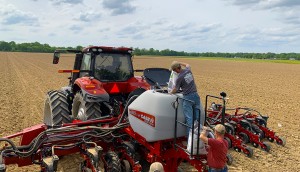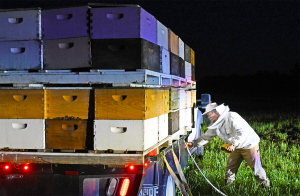This is American agriculture’s big week – Thanksgiving! Our celebration of food takes center stage on family dining tables from sea to shining sea. Not only do we honor the 1% who currently feed us, we also reflect upon the many contributions of the original American agriculturalists, our Native Americans. For starters, they saved the Pilgrims from starvation during their first years in the New World. The Wamponoag tribe utilized their famous “Three Sisters” cropping practice: corn, beans and squash. This synergistic combination worked especially well in the poor, sandy Northeastern soils that didn’t retain water or nutrients. Corn provided the beans a support (living stakes) on which to branch and grow; beans produced nitrogen in the soil that helped the corn grow; vine-producing squash provided water retention and weed control. They fertilized their fields with wood ash from their fires, which are sources of potash and phosphorus, primary plant nutrients (I continue to steal their idea in my garden). And they buried dead fish to improve the organic matter to improve water retention and fertility. They were true pioneers of regenerative farming.
One such pioneer is Fernando Pino, a member of the Zia Tribe, who works at our Huma facility in New Mexico. This past year, Fernando successfully raised a first-year corn crop on his native land, using a heirloom variety. He utilized our dry humates to help vitalize the sandy soil. In an area where corn typically stands about three feet tall, Fernando’s plants towered above me while producing lots of beautiful ears loaded with multi-colored kernels. The harvested corn was ground into flour and used to feed tribe members. This upcoming year, I am beyond excited to have been asked by Fernando to work with and support him in this farming venture. All while keeping with his tribe’s cultural traditions.

Pumpkin pie is the undisputed favorite Thanksgiving dessert, preferred by over one-third of Americans. Coming in second is pecan pie. Boosting high levels of antioxidants and nutrients, the pecan is one of the few edible tree nuts native to the United States, making it part of our country’s agricultural history. Today, 75% of the world’s pecan crop is grown in the United States. The largest pecan producing state is Georgia, followed by New Mexico and Arizona. The name “pecan” comes from the Native American (Algonquin) word “pacane” that translates as “nut requiring a stone to crack.’” Native Americans foraged wild pecans for centuries before planting pecan trees and trading the harvest to European explorers and settlers.
A cultural and marketing icon, the Butterball Turkey Talk Line celebrates its 42th year of helping would-be culinarians prepare their holiday turkeys. It began the same year as Ronald Reagan first took office, the space shuttle Columbia launched, and another cultural icon, MTV revolutionized the music industry (believe it or not, they actually played videos at the time). Six home economists answered cooking questions from 11,000 Americans that first year. Nowadays, you can ask Alexa how to carve your turkey, or conduct an on-line chat. But there are still many Americans who take comfort in personally communicating with a caring and reassuring voice. Last year 50 cooking counselors answered more than 100,000 calls to 1-800-BUTTERBALL. In most cases, they provided validation to those seeking assurance their holiday turkey would not end up like the Griswold’s.
Related Posts

This Week in Ag #40
I’ll never forget the sage words an old farmer told me when I announced my intention to start farming in the late 1990s. I explained that I was not leaving my marketing job and that I was also doing a fair amount of freelance consulting work. He told me, “It’s funny how many other jobs you need...

This Week in Ag #39
Clocks turned back one hour in most of the country over the weekend (a notable exception was Arizona). There’s a popular belief that daylight savings time was intended for farmers. Agriculturists are, of course, infamous early risers, said to awaken with the roosters to do their daily chores. Contrary to popular belief, the idea to “fall...

This Week in Ag #38
When you’re carving your Halloween pumpkins this week, be sure to thank a bee. That’s because pumpkins are not self-pollinating plants. Unlike cotton and soybeans, where pollen produced within a flower fertilizes the ovary of the same flower on the same plant, pumpkins have specific male and female flowers across their vines. So they need bees to carry pollen between the flowers. Pumpkin growers will rent bee colonies during the growing season to ensure better pollination and higher yields.

